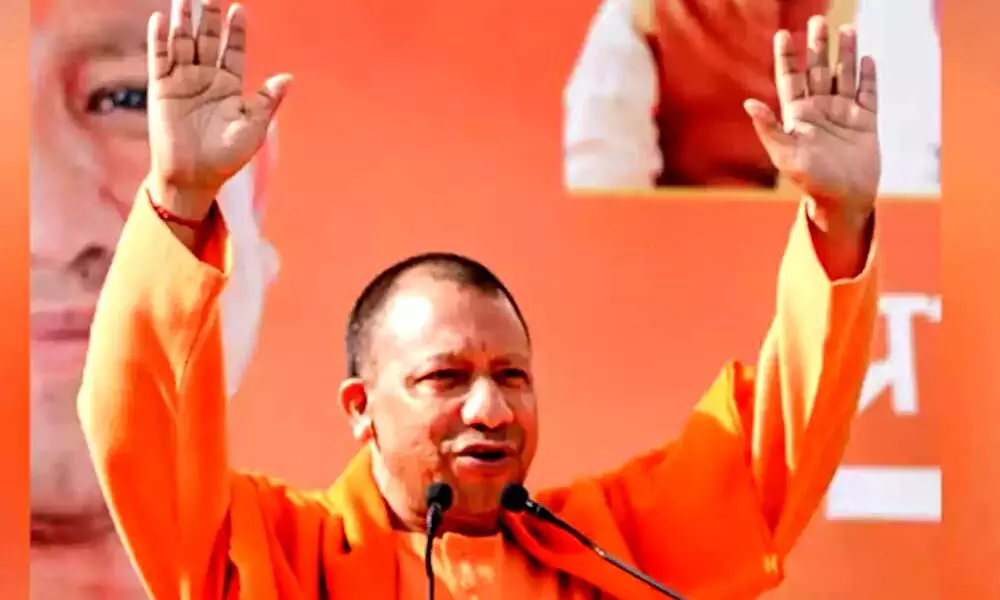The monk who won hearts of millions, set to be CM again
He had entered politics on the directions of his guru in 1998 and at 28 became the youngest Lok Sabha member, winning from Gorakhpur. He went on to represent the parliamentary seat four more times till he became the chief minister of Uttar Pradesh on March 19, 2017
image for illustrative purpose

Lucknow: Yogi Adityanath was an unexpected pick for the Chief Minister's post after the BJP scored a landslide win in the 2017 Uttar Pradesh Assembly polls. A poster boy for Hindutva, saffron-robed Adityanath was considered a firebrand and often accused of making provocative remarks against Muslims.
As Chief Minister of the country's most populous State, he might have toned down. But not by much, his critics say. With the Bharatiya Janata Party set for a second consecutive innings in the State, Adityanath is almost certain to get another stint in office. Born Ajay Singh Bisht in Pauri Garhwal's Panchur (now Uttarakhand), on June 5, 1972, Adityanath left home in 1990 to join the campaign to build the Ram temple in Ayodhya. He also became a disciple of Mahant Avaidyanath of the Gorakhnath temple in Gorakhpur.
After Avaidyanath's death in 2014, he took over as the head of the Gorakhnath `math', a post he still holds and makes frequent trip to the eastern UP town. He was not averse to taking on the BJP then, and founded his own band of volunteers called the Hindu Yuva Vahini. Adityanath went to school in his native village and later completed his bachelor's degree in Mathematics from Hemwati Nandan Bahuguna Garhwal University.
He had entered politics on the directions of his guru in 1998 and at 28 became the youngest Lok Sabha member, winning from Gorakhpur. He went on to represent the parliamentary seat four more times till he became the chief minister of Uttar Pradesh on March 19, 2017. As CM, he took decisions that confirmed his image as a Hindutva mascot. Early in his term, he banned illegal slaughterhouses and the police cracked down on cow slaughter. His government brought an ordinance and later a bill against religious conversion through force or deceit, a move that also seemed to target interfaith marriages.
Other BJP-ruled States followed the UP example, coming up with their versions of the law. Briefly, last year, there was speculation that the BJP wanted to replace Adityanath as Chief Minister. But the rumours died down with top leaders saying that he needed to be back as CM in 2022 if the party sought to return to power at the Centre in 2024.
Party leaders hailed the Adityanath-Narendra Modi 'double-engine' government in the State. The BJP's 2022 assembly election win may have further consolidated his stock in the party. The saffron party is now set to win the UP state polls twice in a row, a feat achieved by no other party in three decades. Adityanath has been blamed by some – and hailed by others – for adopting strong-arm tactics to fight crime.
"Bulldozers", used to raze illegal buildings, have figured repeatedly in campaign speeches. Protests against the Citizenship Amendment Act (CAA) were crushed ruthlessly, and protesters asked to pay for damage to government property. Opposition parties slammed his government over its handling of law and order, alleging that it followed a "thoko niti", or a "fake encounter" policy. Officials deny the allegation.
During this campaign, he has also been accused of "polarisation" of the State's two major communities. He has talked about an 80-20 split of votes, which many thought referred to the Hindu-Muslim ratio. He has claimed that people who say "abba jaan" benefitted during the Samajwadi Party's term in office, when there were power cuts on Diwali but uninterrupted electricity supply during Eid.

